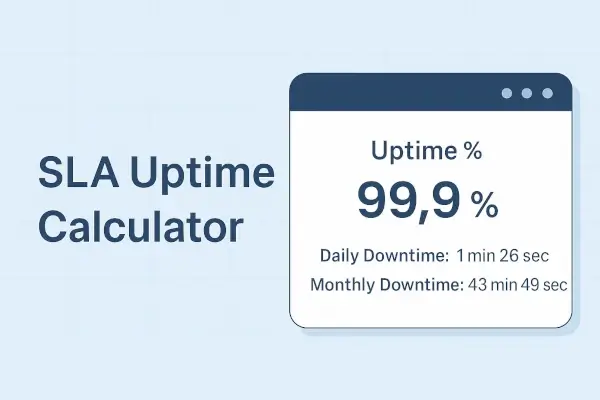
TL;DR A Service Level Agreement (SLA) defines the required uptime for a service. An SLA uptime calculator helps convert uptime percentages into actual allowed downtime across different timeframes. This guide explains how these calculators work, why uptime matters, and how to monitor performance to meet SLA targets.
Table of Contents:
Understanding Service Performance
Server Performance Metrics
Downtime Considerations
Service Level Agreement (SLA)
Monitoring and Reporting
Conclusion
FAQ
A Service Level Agreement (SLA) is a crucial component of any service provider's contract, ensuring a certain level of service quality and availability. Understanding the terms of an SLA is essential for both providers and customers to avoid misunderstandings and penalties, and to ensure continuous access to services, which is crucial for user satisfaction. SLAs are important because they can define the expected level of service and clearly define the responsibilities of both parties.
An SLA uptime calculator is an efficient tool for calculating uptime percentage and determining the allowed downtime.
If you want to quickly calculate the amount of downtime allowed for different uptime targets, try this free SLA uptime calculator. It shows downtime in minutes, hours, days, and a custom timeframe based on the SLA level you choose.
What Does Service Performance Mean and Why Is It Important?
| Uptime % | Daily Downtime | Monthly Downtime | Yearly Downtime |
|---|---|---|---|
| 99% | 14 min 24 sec | 7 hrs 18 min | 3 days 15 hrs 36 min |
| 99.9% | 1 min 26 sec | 43 min 49 sec | 8 hrs 45 min 57 sec |
| 99.99% | 8.6 sec | 4 min 23 sec | 52 min 34 sec |
| 99.999% | 0.86 sec | 26.3 sec | 5 min 15 sec |
Service performance is critical to any business's success, and uptime is a key metric for measuring this performance. "99.9% uptime" refers to a server's reliability and availability, indicating that it is operational almost all the time.
High availability is essential for businesses that rely on fast and reliable networks, and an uptime calculator can help determine the total number of seconds a server is operational in a week. Various factors, including server uptime and user location, can significantly affect service quality and availability. The role of a computer in assessing machine availability is crucial for businesses reliant on consistent performance.
The uptime percentage is a key metric in SLA uptime calculation, and it's crucial to understand how to calculate uptime and downtime. "Five nines" is a reliability benchmark that focuses on achieving nearly perfect service availability.
A reliable SLA calculator can help businesses track their service performance and ensure they meet the required service level agreement. Monitoring web applications can help identify potential fail points in the user journey, emphasizing functions during transactions. The importance of uptime concerning a machine, such as a computer or server, cannot be overstated.
Verifying availability through the provider's network versus third-party suppliers is essential. The operating system's role in gathering detailed user performance data is also significant.
Understanding the implications of percentages in SLAs is important, as these figures represent actual downtime. Server downtime can annoy and frustrate users trying to access a website.
Encouraging readers to apply what they've learned by performing calculations related to server uptime reinforces the educational aspect of the content with practice.
Performance data is collected based on factors such as the user's system and device type. The concept of systems in relation to monitoring and ensuring the functionality of various technological components is also crucial.
Achieving a "three nines" uptime percentage (99.9%) is crucial for minimizing downtime. Website availability is crucial for maintaining user satisfaction and business reputation.
What Are Server Performance Metrics?

Server performance metrics are crucial for evaluating a server's reliability and efficiency. One of the most important metrics is the uptime percentage, which indicates the percentage of time a server is operational. A high uptime percentage, such as 99.9%, is essential for ensuring high availability and reliability, directly affecting user experience and business reputation.
Server uptime is a critical metric for businesses, as it reflects the operational status of their services. The service level agreement (SLA) uptime calculator is an efficient tool for calculating uptime and downtime, helping businesses maintain high availability.
What Should You Consider When Evaluating Downtime?

Downtime can reduce a business's income and harm its reputation. Minimizing downtime as much as possible is important to keep systems running and customers satisfied.
An uptime calculator shows how much downtime is acceptable. It helps confirm whether a service provider meets the promised service levels stated in the agreement.
Downtime should be tracked regularly. Key periods include weekly, monthly, and yearly intervals. Measuring these helps ensure the service remains available and reliable.
An SLA calculator helps businesses see how downtime affects service and supports planning to keep downtime low and performance high.
What is a Service Level Agreement (SLA)?

A Service Level Agreement (SLA) is a contract between a service provider and a customer. It sets clear rules about service quality and availability. The SLA should include details such as uptime percentage, how fast the provider responds, and how quickly problems are fixed. It must also state what each party is responsible for.
SLAs are helpful because they set clear expectations. They help both sides meet their promises and maintain consistent service levels.
An SLA calculator helps businesses build and manage these agreements. It checks if the service meets the required standards.
Why Are Monitoring and Reporting Essential for Service Performance?

Monitoring and reporting are key parts of any Service Level Agreement. They help businesses assess and measure the performance of their services. These processes clearly show service results. They also ensure that both the provider and the customer follow their agreement.
An SLA uptime calculator supports this by creating reports and tracking performance. It helps confirm whether the service meets the required level.
Conclusion
Understanding and managing service uptime is critical for maintaining reliable digital services and meeting user expectations. An SLA uptime calculator is a simple yet powerful tool that helps visualize the impact of different uptime percentages by converting them into actual allowable downtime. This tool allows businesses to set clear service expectations, track performance, and ensure compliance with their service level agreements. Whether you're drafting an SLA or evaluating a provider's claims, knowing how to calculate and interpret uptime is essential for long-term service success.
Frequently Asked Questions (FAQ)
What is an SLA uptime calculator?
An SLA uptime calculator is a tool that helps determine how much downtime is allowed based on a target uptime percentage defined in a service level agreement.
What is considered good uptime?
99.9% uptime (known as "three nines") is generally considered good. It allows for about 43 minutes of downtime per month. Mission-critical systems often aim for 99.99% or higher.
What does 99.99% uptime mean?
99.99% uptime means a service is expected to be available for all but about 4 minutes and 23 seconds per month.
Why is uptime important?
Uptime reflects a service's reliability. Low uptime can cause revenue loss, harm brand reputation, and lead to SLA penalties.


 Copyright 2000-2025, WebSitePulse. All rights reserved.
Copyright 2000-2025, WebSitePulse. All rights reserved.